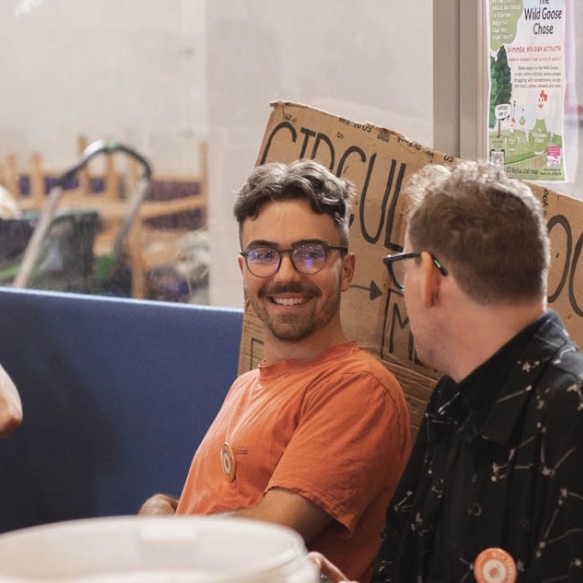Transform Your Food Waste into Fertile Soil with Bokashi Composting
- Alex Montgomery
- Oct 25
- 3 min read
Food waste doesn’t have to end in the bin. With bokashi composting, you can transform kitchen scraps into living, nutrient-rich soil all from the comfort of your home.
At Generation Soil CIC, we use the bokashi method across Bristol to turn household waste into fertile compost that restores soil health and reduces emissions. Whether you live in a flat, terrace, or garden home, here’s how you can do the same.

What Is Bokashi Composting and How Does It Work?
“Bokashi” means fermented organic matter in Japanese. Unlike traditional composting, which requires oxygen, bokashi uses anaerobic fermentation, a process powered by the same beneficial microbes that make kimchi, sauerkraut, and other delicious fermented foods. In this case, it is used to ferment food waste without that nasty rotten smell or pests.
Here’s how it works:
You layer food waste with bokashi bran, a mix of molasses, bran flakes, and effective microorganisms (EM).
The microbes ferment the waste inside a sealed bucket for about two weeks.
The result is pre-compost, an acidic and partially digested material that finishes breaking down once buried in soil or added to a compost heap.
Because bokashi is sealed, it’s perfect for urban composting where space and odour control matter most.

Step-by-Step Guide: How to Use a Bokashi Bin at Home
Setting up a bokashi system is simple and low-maintenance.
1️⃣ Get the Right Kit
Use an airtight bokashi bin with a tap at the bottom to drain excess liquid. You’ll also need bokashi bran. At Generation Soil, we use Agriton, but there are plenty of other suppliers.
2️⃣ Add Your Food Waste
Add kitchen scraps, daily vegetable peelings, cooked leftovers, meat, dairy, and even bread. Sprinkle a handful of bokashi bran over each layer to activate fermentation.
3️⃣ Keep It Sealed
Press the waste down to remove air pockets and keep the lid tightly closed. Oxygen will disrupt fermentation and cause odour.
4️⃣ Drain the Liquid (Bokashi Juice)
Every few days, drain the liquid using the tap. Dilute 1 tbsp in 2 litres of water for a nutrient-rich, natural plant fertiliser, or pour it down drains to prevent odours and support healthy bacteria.
5️⃣ Bury or Compost the Fermented Waste
After two weeks, when the bucket is full and the contents have a pleasant pickled smell, bury the pre-compost in soil or add it to a compost bin. It will transform into dark, fertile compost teeming with microbial life almost overnight!

Bokashi vs Traditional Composting: What’s the Difference?
Feature | Bokashi Composting | Traditional Composting |
Process | Anaerobic fermentation | Aerobic decomposition |
What You Can Add | All food waste (including cooked & meat) | Mostly raw fruit/veg & greens |
Timeframe | 4–6 weeks total | 3–6 months |
Odour & Space | Low-odour, compact, indoor | Outdoor only, larger space |
End Product | Fermented pre-compost → rich soil | Mature compost |
Both methods regenerate soil, but bokashi’s ability to handle all food types and operate indoors makes it ideal for flats, schools, and small businesses across Bristol.
The Environmental Benefits of Bokashi Composting
Choosing bokashi isn’t just a convenience; it’s a climate action.
Reduces Methane Emissions: Food waste in landfill releases methane, a greenhouse gas 80 × stronger than CO₂. Bokashi keeps food out of landfill entirely.
Regenerates Soil Health: Bokashi compost reintroduces organic matter and beneficial microbes, rebuilding degraded urban soils.
Closes the Nutrient Loop: Instead of “waste in, energy out,” as with industrial anaerobic digestion, bokashi returns nutrients directly to the earth.
Empowers Communities: Local hubs create shared composting spaces, teaching soil literacy and resilience.
Why Bokashi Composting Works Best for Urban Living
Urban homes often lack gardens, time, or outdoor space for composting. Bokashi solves all three barriers.
It’s compact: fits under your sink or in a cupboard.
It’s clean: no flies, minimal odour, and easy to manage.
It’s educational: a daily reminder of how food connects to soil.
In Bristol, our Bristol Living Compost Project uses bokashi fermentation as the first step in a city-wide nutrient loop. Residents fill their bins, we collect and transform the material, and living compost is returned to gardens, allotments, and schools across the city.
How to Get Started with Bokashi in Bristol
Generation Soil offers everything you need to begin:
Workshops on home composting and soil regeneration.
Community collections through the Bristol Living Compost Project.
Let us know if you'd like to book a workshop or sign up for community composting.
Reconnecting Food, Waste, and Soil
Bokashi composting shows that regeneration can begin right in your kitchen. Every bucket filled is a kilo of life returned to the soil, a small act with planetary impact. Let’s move from waste management to nutrient stewardship and rebuild the living systems that sustain us all.



Comments